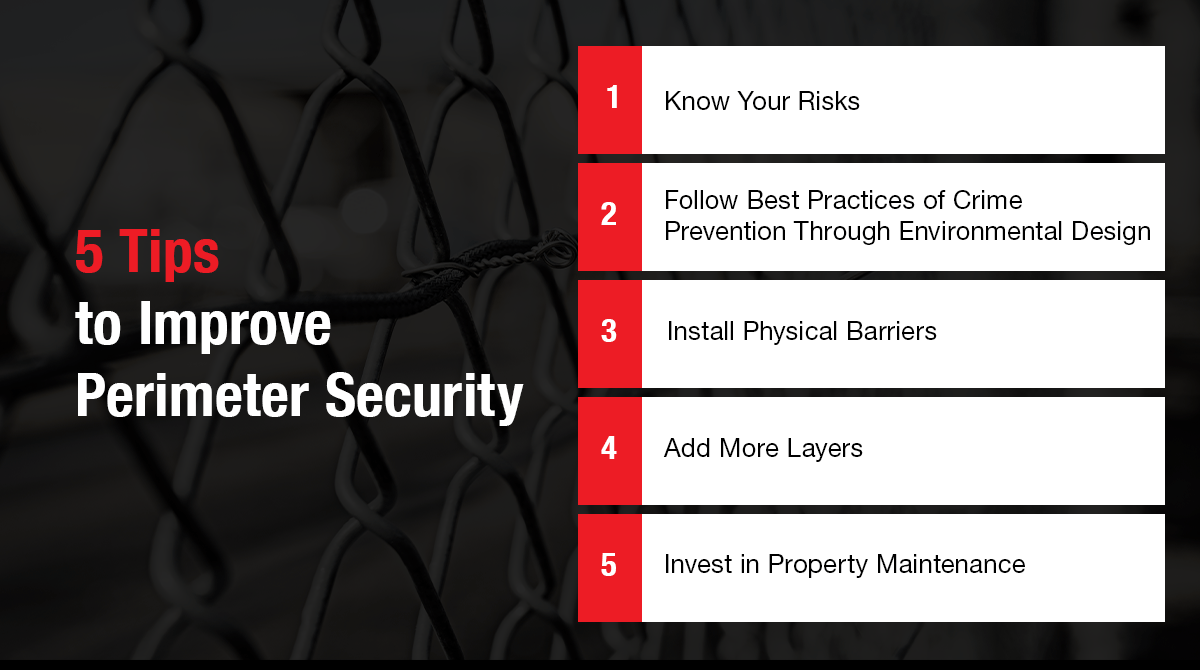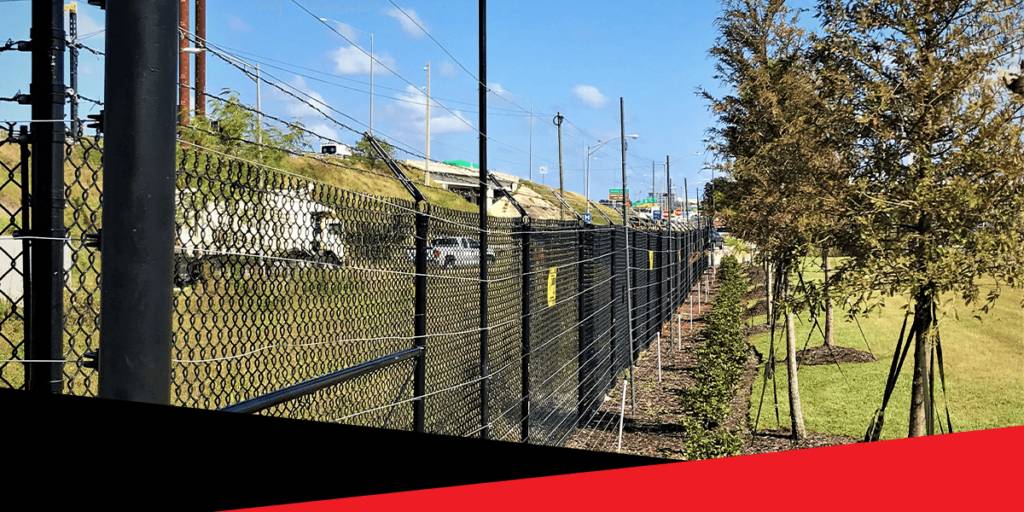Companies countrywide share a common issue. External theft is growing, stretching law enforcement resources and delaying responses. The best way to prevent your business from becoming a statistic is to stop criminals where they start — at your property’s perimeter. Learn more about why proactive measures matter and explore tips on how to improve perimeter security for effective protection.
Why Should Your Business Focus on Improving Perimeter Security?
No property or industry is immune from targeting by thieves if the reward potential is high enough. Plus, the costs of unauthorized access go beyond asset loss. Companies that experience theft may also see:
- Regulatory fines: A physical security breach in heavily regulated industries may result in regulatory fines and penalties for legal non-compliance.
- Property damage: Property damage often accompanies theft, leaving organizations with repair or replacement bills and increased threats until fixes occur.
- Higher insurance premiums or cancelations: Break-ins mean spending time filing insurance claims instead of focusing on business growth and core operations. Many insurance companies deny claims, substantially raise premiums, or even cancel policies following repeat thefts.
- Customer action: Customers whose belongings were stolen or damaged are more likely to choose a competitor in the future. Legal action is also possible. One financial company settled a class-action lawsuit for $25 million following a physical breach that exposed customer data.
Conversely, prioritizing perimeter security drives value for your business in several key ways. For example, your insurer may reward you for being proactive about lowering the potential for claims. Since they base premiums on claims experience and risk, insurance companies sometimes offer discounts for installing comprehensive, proactive protection. We’ve even seen carriers rescind cancelations and decrease premiums in some cases.
Perimeter security also promotes greater peace of mind for property visitors. These solutions help fulfill the three basic principles of any physical security strategy — detect, deter, and delay crime. Employees, guests, and customers feel safer when they see you emphasize security.
5 Tips to Improve Perimeter Security
The following tips can help you strengthen your perimeter security posture.

1. Know Your Risks
The first step in designing the ideal property protection strategy for your business is knowing and assessing your risk. Answering the following questions will help you gain insights into your potential threats:
- What assets on your property represent the most likely targets?
- What skills would a would-be criminal need to gain property access?
- How many entry and exit points are there?
- Do site-specific threats exist, such as nearby vegetation that could allow a thief to climb over a fence?
Collaborating with a perimeter security expert will help. These professionals have extensive training in security threat identification and developing tailored strategies to mitigate the risks.
2. Follow Best Practices of Crime Prevention Through Environmental Design
Crime Prevention Through Environmental Design (CPTED) is a strategy that leverages multiple disciplines for crime reduction. Its fundamentals include:
- Territorial control — helping encourage accountability and a sense of ownership in public spaces that deters criminal activity.
- Natural surveillance — increasing visibility to make it easier for passers-by and residents to observe crime.
- Image and milieu — fostering a sense of connectedness among community members and improving curb appeal.
- Access control — implementing measures to prevent unauthorized access.
Activities you can consider as part of creating a CPTED-based approach include:
- Forming a community watch and building collaboration between local residents, businesses, and law enforcement.
- Hosting inclusive community events that bring together people of various demographic backgrounds.
- Installing access security devices on structural entry and exit points.
3. Install Physical Barriers
Physical barriers are the cornerstone of perimeter security systems since they’re the first defense potential thieves encounter. Fences are the most common physical barrier to prevent unauthorized access to your property. Options include chainlink, palisade, wood, stone, and wire mesh. All are compatible with the one type that stops criminals better than any other — an electric fence.
Options like The Electric Guard Dog™ Fence from AMAROK are a powerful, medically safe, and legal deterrent. These imposing structures and warning signs visually remind would-be thieves that their actions have consequences. Attempted breaches trigger the fence to deliver pulsed electricity every 1.3 seconds, successfully encouraging criminals to abandon their activities.
Electric fences are also compatible with other physical barriers like Gate Access Control and bollards. These solutions help limit potential entry and exit points to simplify access management.
4. Add More Layers
Using multiple layers of security offers the most effective protection for your property. This approach unifies security to eliminate gaps often created by relying on cameras, alarms, or security guards alone. Consider integrating your fence and access control measures with additional solutions like:
- Lighting: Install commercial lighting to increase visibility on your property and help deter criminal activity. Perimeter alarm-based lighting draws extra attention with bright white lights when the system detects an attempted breach.
- Video surveillance: Add video surveillance cameras with around-the-clock remote monitoring to benefit from eyes on your property 24/7/365. These systems help satisfy visual verification requirements in many jurisdictions.
- Alarms and sirens: Give thieves an audible warning any time they attempt a breach. You can combine alarms with lights in a single solution ideal for detection and response in more remote areas of the property.
- Fencing enhancements: Customize your fence with enhancements that boost its safeguarding capability. Options like lay-down fencing, angled fencing, and ground wire monitoring provide additional peace of mind against potential threats.
- Detection sensors: Upgrade your fence line with a fully featured perimeter detection system. These solutions raise protection with sensors capable of detecting lifting, climbing, or cutting.
- Human guards: Consider the possibility of adding human guards. While not effective on their own, they can offer value as a visual deterrent and on-site responder.
5. Invest in Property Maintenance
Successful perimeter security strategies require an ongoing commitment to property upkeep. Lightbulbs may burn out, or cameras can become obsolete and need to be upgraded. Implementing regular inspections and scheduled maintenance can help you keep all your layers functioning at their peak. Build a checklist that includes tasks like:
- Trim overgrown vegetation to limit potential hiding places and ensure cameras have clear views.
- Test all lights, cameras, alarms, and detection systems to see that they perform properly.
- Replace any burned-out bulbs.
- Inspect systems for loose connections or wires that could interfere with safe, accurate operation.
Take the Smartest Approach to Perimeter Security With AMAROK
AMAROK provides the ultimate perimeter security solution with a legal, medically safe electric fencing system and integrated technologies. We’ll work with you to create the most effective protection for your property based on its unique threat landscape. Our solutions help over 8,000 businesses across many industries stop 99% of external theft. No upfront investment is required — our unique security-as-a-service model covers installation, maintenance, and repair for one monthly fee.
Connect with your local perimeter security expert today, or reach out to us to learn more.






